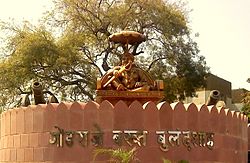Bakht Buland Shah
| Bakht Buland Shah | |
|---|---|
| Gond King | |
 | |
| Reign | 17th Century |
| Predecessor | Kok shah |
| Successor | Chand Sultan |
| Dynasty | Rajgond |
Bakht Buland Shah was a ruler of the Rajgond dynasty. He added to his kingdom, the territories of Chanda and Mandla, and portions of Nagpur, Balaghat, Seoni, and Bhandara. He also annexed the adjoining Rajput kingdom of Kherla. The present districts of Chhindwara and Betul also fell under his control. A great warrior, he went on to conquer Pauni, Dongartal, Sivni&Katangi.
History idolizes him as the founder of the Nagpur city. Bakht Buland Shah founded the city of Nagpur by joining the twelve small villages formerly known as Rajapur Barsa or Barasta. In 1702 Many towns and villages were founded. All the smaller villages were merged. After giving a proper shape to his kingdom, he encouraged people to settle and thus facilitated trade & Commerce. His rule epitomizes an era of great reforms. Agriculture, trade, and commerce made considerable advances. He constructed a Mosque in the Fort of Nagpur which initiated the Islamic religion & culture in Nagpur.
Bakht Buland starts off in the service of the Mughal emperor, Aurangzeb, embracing Islam, and is officially recognised as the raja of Deogarh by the Mughal court. Bakht Bulund Shah is said to later rebel against the Mughals and snatch portions of their territory, during the Mughal war against the Marathas.[1]
Life[]
A prince of the kingdom of Deogarh-Nagpur. The next Raja of Deogarh was Chand Sultan, who resided principally in the country below the hills, fixing his capital at Nagpur which he made a walled town. On Chand Sultan's death in 1739, Wali Shah, an illegitimate son of Bakht Buland, usurped the throne and Chand Sultan's widow invoked the aid of the Maratha leader Raghuji Bhonsle of Berar in the interest of her sons Akbar Shah and Burhan Shah. The usurper was put to death and the rightful heirs placed on the throne. After 1743, a series of Maratha rulers came to power, starting with Raghoji Bhonsle, who conquered the territories of Deogarh, Chanda and Chhattisgarh by 1751.[2]
In 1803 Raghoji II joined the Peshwa against the British in the Second Anglo-Maratha War, but the British prevailed. After Raghoji II's death in 1816, his son Parsaji was deposed and murdered by Mudhoji II. Despite the fact that he had entered into a treaty with the British in the same year, Mudhoji joined the Peshwa in the Third Anglo-Maratha War in 1817 against the British, but suffered a defeat at Sitabuldi in present-day Nagpur city. The fierce battle was a turning point as it laid the foundations of the downfall of the Bhonsles and paved the way for the British acquisition of Nagpur city. Mudhoji was deposed after a temporary restoration to the throne, after which the British placed Raghoji III the grandchild of Raghoji II, on the throne. During the rule of Raghoji III (which lasted till 1840), the region was administered by a British resident. In 1853, the British took control of Nagpur after Raghoji III died without leaving an heir.[3]
References[]
- ^ "Gond King". Archived from the original on 2014-05-31.
- ^ "Gond King". Archived from the original on 2014-05-31.
- ^ "Gond King".
- History of India
- History of Nagpur
- History of Maharashtra
- Maharajas of Nagpur